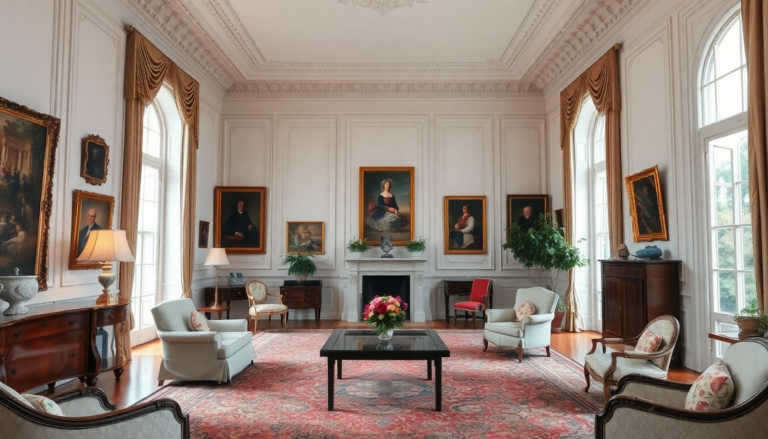Argomenti trattati
When you think of the White House, images of grandeur, history, and politics come to mind. But beyond the iconic façade lies a treasure trove of design evolution that reflects the personality of each administration. From the understated elegance of the Kennedys to the bold choices of the Trumps, the interiors of this historic residence are a canvas of changing tastes and styles. Have you ever wondered how the décor of the People’s House has morphed over the centuries? Buckle up as we dive into the colorful, often surprising, history of the White House’s interiors!
A glance back at history
The White House, originally known as the Executive Mansion, was designed by Irish architect James Hoban in the Neoclassical style, a choice that still resonates today. Its construction spanned from 1792 to 1800, utilizing Aquia Creek sandstone painted white to prevent cracking in the cold. Interestingly, the very first occupants, George Washington and John Adams, had lived in a different presidential residence located in Philadelphia. It was only after Adams moved in, just before his presidency ended, that the White House began its storied existence.
Did you know that until 1901, the White House was actually called the Executive Mansion? That was until Theodore Roosevelt, feeling the name was a bit too generic, coined the term “White House”—a name that has stuck like glue ever since. Imagine the historical significance behind that simple change! When John Adams first entered the White House, it was a far cry from the grand residence we know today; the East Room was even used as a laundry room by Abigail Adams. Talk about humble beginnings!
Presidential influences on decor
As the years rolled on, the White House transformed dramatically under each new president. Thomas Jefferson was the first to make the White House his full-time home, and he set a precedent for the opulent yet livable interiors. By importing furnishings and wallpaper from France, he infused a touch of European elegance into the residence. I remember reading how Jefferson loved to host gatherings, and it’s easy to see why he wanted an inviting space!
Fast forward to 1882, when President Chester Arthur commissioned Louis Comfort Tiffany to redesign several key rooms, including the Red Room and the Entrance Hall. Tiffany’s creations added a splash of artistic flair, and I can only imagine how vibrant those rooms must have looked at the time! However, just two decades later, Roosevelt deemed the designs outdated and had them removed, sparking a cycle of continuous change that has defined the White House.
Renovation and restoration efforts
The White House has seen its share of renovations, particularly after the tumultuous years of the Great Depression and World War II. In 1948, the building was declared unsafe, leading to a significant three-year reconstruction overseen by Harry S. Truman. The irony? Truman and his family had to live elsewhere during this massive project! Can you imagine the chaos of moving out of the iconic residence just to have it rebuilt?
However, one of the most important renovations came during Jacqueline Kennedy’s time as First Lady. Her passion for historic preservation led to a $2 million restoration that not only honored the past but also made the White House more accessible to the public. During a televised tour in 1962, she famously said, “It just seemed to me such a shame when we came here to find hardly anything of the past in the house.” Her efforts ensured that the historical significance of the White House would never be forgotten.
The role of interior decorators
As each First Lady brought her personal touch, the interiors underwent continuous transformation. For instance, during the Kennedy administration, Sister Parish and Stéphane Boudin played pivotal roles in redesigning the living spaces, showcasing American craftsmanship and style. It’s fascinating how these decorators took the essence of the White House and added layers of storytelling through color, fabric, and furniture. Parish, known for her wit and impeccable taste, reportedly clashed with the Kennedys over decor decisions. Imagine being part of such high-stakes design meetings!
Fast forward to the Clinton era, where Kaki Hockersmith replaced the infamous bird wallpaper installed by the Reagans, marking yet another shift in the visual narrative of the White House. Each change reflects not only the personal tastes of the First Family but also the broader cultural shifts happening across the country.
A modern twist on tradition
In recent years, the White House has continued to evolve. Under Barack Obama, the residence was infused with contemporary art, while Donald Trump opted for a more ornate, gold-heavy aesthetic. Jill Biden’s choice of interior designer Mark D. Sikes for the East Wing office exemplifies a modern approach to traditional design, aiming to create a welcoming, homey atmosphere while respecting the historic fabric of the building. Sikes took great care to blend comfort with elegance, proving that even the People’s House can embrace fresh, vibrant designs.
So, what’s next for the interiors of this iconic residence? As new administrations take charge, the White House will undoubtedly continue to reflect the evolving tastes and values of the nation. Perhaps one day, we’ll see a bold new trend emerge that will reshape the way we view this beloved building!
As we look back at the rich tapestry of design choices that have defined the White House, it’s clear that this residence is more than just a symbol of power; it’s a living museum that encapsulates the spirit of each administration. Whether you’re a history buff, a design enthusiast, or simply curious about how this national landmark has changed over the years, the story of the White House’s interiors is nothing short of fascinating.

